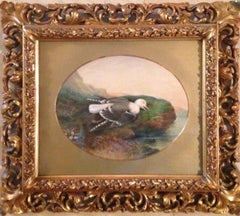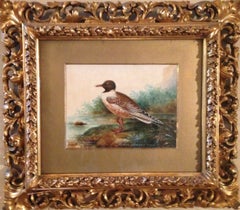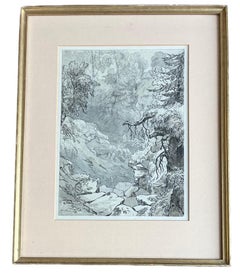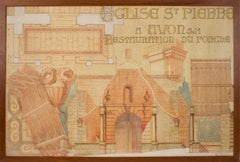John Duncan Art
to
2
2
2
2
2
“Dead Gull”
By John Duncan
Located in Southampton, NY
In original gold leaf pierced frame
Signed and dated lower right 1902
Sight size 7.5 x 9.5 in
Category
Early 1900s Academic John Duncan Art
Materials
Paper, Watercolor
$1,200 Sale Price
50% Off
Black-Headed Gull
By John Duncan
Located in Southampton, NY
In original gold leaf pierced frame
Signed and dated lower left 1902
Sight size 6 x 8 in
Category
Early 1900s Academic John Duncan Art
Materials
Paper, Watercolor
$1,920 Sale Price
20% Off
Related Items
Early 19th Century English watercolour of woodland near Croxdale Hall
Located in Harkstead, GB
A very attractive and meticulously executed view of a rocky landscape within the woods dating to 1823. This would suit a library or study with its muted tones and skifull draughtsmanship.
William Nicholson (1781-1844)
Near Croxdale Hall
Signed with initials and inscribed with title and date 1823
Pen, ink and grey wash
11 x 8 inches, image only
17 x 13 inches without frame
The portrait-painter and etcher William Nicholson was born in Ovingham-on-Tyne, Northumberland, on Christmas Day 1781. His family transferred to Newcastle when his father was appointed Headmaster of the city's Grammar School. At an early age, though, Nicholson appears to have moved to Hull where he made his artistic debut, painting miniatures of officers garrisoned there. He was almost entirely self-taught, learning his craft through the close study of artworks in private and public galleries. He subsequently returned to Newcastle where he received many commissions to paint portraits of the old families of Northumberland. In 1808, he began to exhibit at the Royal Academy, continuing to do so until 1822. By 1814, Nicholson, whose mother was a Scot, had moved to Edinburgh where he set up as a miniaturist and painter in oils. Soon, however, he began to specialize in watercolour portraits. Early subjects included the actor Daniel Terry and the poet and novelist James Hogg. In 1818 he began to publish a series of Portraits of Eminent Scotsmen, etched from his own portraits and those of other painters. Besides Scott and Hogg, the subjects included the writers Robert Burns, John Wilson ('Christopher North'), and Lord Jeffrey, the painters Sir Henry Raeburn, the divines Alexander Carlyle and Alexander Cameron, the engineer James Watt, the architect John Playfair, and the song-collector and composer George Thomson...
Category
Early 19th Century Academic John Duncan Art
Materials
Paper, Watercolor, Ink, Pen
$402 Sale Price
20% Off
H 11 in W 8 in D 1 in
Architecture Sketches Study Drawing, Romane Church in France by Maurice Lambert
Located in Atlanta, GA
Architectural Study for the Restoration of Saint-Pierre Church in Avon, France.
This unique architectural study was created as part of a church renovation project in a suburb of Pari...
Category
Late 19th Century Academic John Duncan Art
Materials
Ink, Watercolor, Pencil
$2,850
H 27.56 in W 40.94 in D 0.82 in
Ponte Rialto in Venice Landscape Painting Oil on Canvas with Frame
Located in Rome, IT
Early 20' Century large cityscapes of Venice oil on canvas with a finely carved gilt wood frame.
Rialto Bridge painting is beautiful reminder of Venice, Italy's iconic bridge. The...
Category
20th Century Academic John Duncan Art
Materials
Oil
$10,620
H 48.04 in W 68.12 in D 3.94 in
Untitled (Cafe Interior), Shimshon Holzman
By Shimshon Holzman
Located in Fairfield, CT
Artist: Shimshon Holzman (1907-1986)
Title: Untitled (Cafe Interior)
Year: 1962
Medium: Watercolor and graphite on wove paper
Size: 27.75 x 19.75 inches
...
Category
1960s Academic John Duncan Art
Materials
Watercolor, Graphite
$2,200 Sale Price
20% Off
H 27.75 in W 19.75 in
Cavalry Charge 1st Empire - Edouard Detaille - French art
By Jean Baptiste Édouard Detaille
Located in PARIS, FR
Conditions : Very good original Conditions including a beautiful frame. Framed under glass, this rare composition for sale is an exceptionnel piece for Art collectors.
Signed and d...
Category
Late 19th Century Academic John Duncan Art
Materials
Tempera
$10,207
H 27.56 in W 19.69 in D 1.97 in
A Fine French 19th Century Oil on Canvas 'A Young Girl Holding a Bird's Nest'
By Charles Joshua Chaplin
Located in LA, CA
Charles Joshua Chaplin (French, 1825-1891) 'The Bird's Nest' A very fine and charming Rococo revival style oil on canvas depicting a young girl, dressed in 18th century costume and resting by a river bank, holding a bird's nest and one of the tiny eggs. Her bonnet resting to her side and a wicker basket full of hand-picked flowers by her feet; within a later giltwood carved frame. Signed: ChChaplin (lower left). Circa: 1870-1880.
Canvas Height: 31 1/2 inches (80 cm)
Canvas Width: 17 15/16 inches (45.5 cm)
Frame Height: 38 5/8 inches (98 cm)
Frame Width: 24 3/4 inches (63 cm)
Frame Depth: 2 3/8 inches (6 cm)
Charles Joshua Chaplin (8 June 1825 – 30 January 1891) was a French painter and printmaker who painted both landscapes and portraits. He worked in techniques such as pastels, lithography, watercolor, chalk, oil painting and etching. He was best known for his elegant portraits of young women.
Chaplin was born on 8 June 1825 in Les Andelys, Eure, France. His mother, Olympia Adelle Moisy, was French, whereas his father, John Chaplin, was an art broker from England. Charles Chaplin spent his whole life in France, becoming a naturalized citizen in 1886. He studied at the École des Beaux-Arts in Paris from 1840, and he took private lessons in the studio of Michel Martin Drolling, whose apprentices included Paul Baudry, Jules Breton and Jean-Jacques Henner. Later he also taught at the École des Beaux-Arts.
In 1845, he entered the Paris Salon, the official art exhibition of the Académie des Beaux-Arts, as a portrait and landscape painter with the painting Portrait of the Artist's Mother. Chaplin conducted art classes specifically for women at his studio, including Marie Joséphine Nicolas. The American artist Mary Cassatt, the French artist Louise Abbéma and the English artist Louise Jopling were among Chaplin's students. His son Arthur Chaplin was also a painter.
Early Work:
Chaplin made his debut at the Salon with portraits, but he also painted landscapes, particularly the countryside of Auvergne. His early works, from 1848 to 1851, were painted in a manner characterized by an interest in realism, a style established in the French Second Republic, that had the motto Liberté, égalité, fraternité, and was ruled for three years by the republican government of France from the 1848 Revolution until the 1851 coup by Louis-Napoléon Bonaparte. Realism was an artistic movement that began in France in the 1850s, after the 1848 Revolution. From the late 18th century Romanticism dominated French art and literature but was spurned by Realists, who revolted against the display of the emotions of the Romantic movement, seeking to depict real and characteristic contemporary individuals and situations with truth and accuracy.
Chaplin painted many works in his early days, including floral studies that were displayed at the Salon de las Flores. Later, in the late 1850s, he abandoned naturalism, his earlier style, exchanging it for a more graceful, elegant and supple technique that brought him a certain notoriety in France during his time as a portrait painter; as such he embraced the idyllic and voluptuous and fashionable style of the prominent French painter, François Boucher (1703–1770).
He also embraced the tradition of the great English portraitists and developed his very own style of painting but was inspired by the British painters Joshua Reynolds and Thomas Gainsborough. He used to engrave the works of the Dutch artist Pieter Paul Rubens and gained further influence from his work.
Later Work:
Gradually the muddy colours used by Chaplin transformed into white, grey and pink, depicting his models with an opalescent, mother-of-pearl complexion by applying a subtle palette of rosy flesh tones and light greys. After painting portraits and trying his skills on ornamental painting, Chaplin took up genre painting in the 1850s. His favourite subjects are the feminine grace of a young woman's everyday life. He portrays women in several poses: resting; grooming; singing; and reading. He captures them with lightness and carelessness and accentuates the decorative elements of the composition.
Empress Eugénie, the wife of Napoleon III and an admirer of the "Pompadour style", rapidly fell under the enchantment of the painter's neo-Rococo works. Chaplin was among Napoleon III and Empress Eugénie's favourite court artists. In 1859, when his portrait of Aurora was banned by the judges of the Salon as "too erotically suggestive", Napoléon III defended Chaplin and overturned the disqualification order. He was similarly valued as an interior decorator and was appointed to remodel the decor of Empress Eugénie's rooms.
His sensual portraits of women and young girls, often with models posed erotically in hazy surroundings and frequently wearing transparent clothing, attracted the interest of the high society and aristocracy of Paris during the French Third Republic (1870–1940) guaranteeing his success and wealth. He was one of the most popular painters of his time, but nowadays his work is almost unknown, in spite of the fact that his works hang in many major museums around the world.
He employed his Rococo style for his mythological scenes and genre scenes paintings. His genre pictures formed a significant part of his work. In 1861, working as a decorative painter. Chaplin painted the doors and several glass panels above them of the Salon des Fleurs in the Tuileries Palace. The Palace was gutted by fire in 1871 and its ruins swiftly demolished.[9] He also undertook decorating work in the Salon de l’Hémicycle of the Palais de l’Elysée.
Honours and awards:
As a member of the Académie royale de peinture et de sculpture, Chaplin exhibited his paintings at the Paris Salon, the official exhibition venue of members' work. He began exhibiting his paintings at the French Artists' Salon in 1845 and was represented there habitually each year. These exhibitions made him one of France's most famous portrait artists. Commencing in 1847, his work was exhibited regularly at the Royal Academy in London.
During his lifetime, he received acclamation for his artistic talents by the award of several medals: a third class medal in 1851; a second class medal the following year; and an Honour Medal...
Category
19th Century Academic John Duncan Art
Materials
Oil
$64,500
H 38.63 in W 24.75 in D 2.38 in
Landscape in Provence Watercolor Painting by Francois Pascal, circa 1940
Located in Atlanta, GA
Step into the serene charm of southern France with this captivating watercolor landscape artwork by François Pascal (France, 19th century–1948). Expertly painted on paper, this work ...
Category
1940s Academic John Duncan Art
Materials
Watercolor
$1,800
H 19.13 in W 28.38 in D 1.57 in
Antique Female American Orientalist painting ARABS PRAYING outside MOSQUE
Located in New York, NY
Maria Martinetti was born in 1864 in Italy. Martinetti attended the Academy of Fine Arts in Rome, studying under the Orientalist painter Gustavo Simoni. Martinetti exhibited works in...
Category
1880s Academic John Duncan Art
Materials
Watercolor
$6,500
H 18 in W 21 in D 3 in
A Fine Victorian Oil on Board Titled "A Lady Standing by a Sundial in the Park"
By Henry John Yeend King
Located in LA, CA
Henry John Yeend King R.B.A, R.I., R.O.I. (British, 1855-1924) "A Victorian Lady Standing by a Sundial in the Park" Oil on panel. Signed lower right: Yeend King. "YK" Sticker en ver...
Category
Late 19th Century Academic John Duncan Art
Materials
Oil
$14,850
H 23.13 in W 19.13 in D 2.5 in
Orientalist View With Characters - Gouache 1894
By Paul Pascal
Located in Saint-Ouen, FR
PASCAL Paul (1832-1903)
Orientalist View With Characters
Gouache on card signed low right and dated 1894
New golden frame
Dim gouache : 42 X 58 cm
Dim Frame : 61 X 78 cm
PASCAL Paul...
Category
1890s Academic John Duncan Art
Materials
Gouache
$6,136
H 24.02 in W 30.71 in D 1.58 in
Napoleon III-Review by Edouard Detaille - Tempera - signed lower right
By Jean Baptiste Édouard Detaille
Located in PARIS, FR
This artwork might be one of two versions, the other one being in the Museum in les Invalides Paris.
Note. This version has a more accomplished academic style.
Dimensions with original gold frame 107 x 87 cm
Conditions Excellent overall, supported by an original frame withan antique glass.
EDOUARD DETAILLE
The emperor is accompanied by his aide-de-camp, Colonel Castelnau, and Marshal Canrobert. In a gilded wooden frame, under a Marie Louise blue background.
Life and time
Born in 1848 into a close-knit bourgeois family, Édouard Detaille, the eldest of eight children, displayed early talent in drawing. “He was a prodigy,” notes François Robichon. By the age of thirteen, he exhibited an astonishing surety of hand and a phenomenal sense of composition. His father, connected to Horace Vernet, encouraged him. At seventeen, after passing his baccalaureate, he entered Meissonier’s studio. This relationship, which developed into mutual affection, spared Detaille the academic detour through the École des Beaux-Arts. Rather than dictating an official art style, Meissonier, at the peak of his fame, traveled with his students, introducing them to the nuances of Titian, Rembrandt, and Rubens in Brussels and Lille.
In 1867, the Paris of “free trade” dominated the world through the technological revolutions of the Universal Exhibition, and the amiable young man, striking in appearance, discovered the salon of Princess Mathilde and the theater of Dumas fils. He even approached the Empress, noting in his journals, “Not bad, the Empress.” This observation encapsulated Detaille: he had no doubts about his talent, cultivated panache, enjoyed the company of beautiful women, and aimed to conquer the circles of power without sacrificing his freedom.
From childhood, he listened to his calling: “Before I could read, I could guess the subjects of battles, the names of famous generals, the weapons of officers and soldiers from the images I admired in the books of Norvins and Laurent de l'Ardèche.” He mingled with collectors and regularly attended military reviews on the Champs-Élysées. His first painting exhibited at the Salon in 1868, “La Halte de tambours,” was praised by critics who immediately recognized “a remarkable truth of observation and simplicity of effect.” The purchase of this work by Princess Mathilde, cousin of Emperor Louis-Napoleon, made Detaille, at twenty, an envied celebrity known to Sainte-Beuve, Théophile Gautier, the Goncourt brothers, and Flaubert. The young artist’s humanistic vision contrasted with the compositions of his predecessors, depicting soldiers in maneuvers, contemplative and resigned as war loomed.
**The Combatant’s Vision**
The Siege of Paris, where he nearly lost his life in 1870, and the deaths of two brothers in that defeat darkened his outlook. From 1871 onward, Detaille no longer concealed the cruelties of war: German riflemen mowed down by machine gun fire, cavalrymen and panicked horses caught in ambushes, fields plowed by shells strewn with dead animals. The unvarnished tragedy: “It is an absolute fact that no painter has ever rendered a battlefield covered with corpses as it is,” commented Jules Claretie. The fallen bodies still bear the appearance of life in their frozen rigidity. Detaille’s testimony of the devastating defeat and the catastrophic effects of the first total war in history was not a celebration of heroism but a lament, a “lesson in darkness.” “From war, once considered the supreme effort of human genius, we now see only melancholy and horrors,” judged one writer in response to his canvases.
“Detaille experienced the reality of combat at a young age during a war that foreshadowed the two world conflicts of the 20th century,” explains François Robichon. With great realism, Detaille painted war from the perspective of the combatant. He introduced a humanity and a critical lucidity regarding the evolution of warfare. His works intensely captured the violence and firepower of new weapons like machine guns. Before he turned thirty, Detaille had become a chronicler of these painful years. He exhibited, as a critic noted, a “striking portrait of modern war” that both French civilians and soldiers had experienced firsthand. He embodied a youth humiliated and eager for revenge. Yet this scrupulous artist also remembered, in his expansive landscapes—from the chalky plateaus of Île-de-France to the Russian plains—the lessons of Corot and Courbet. Manet was not far off. “I wouldn’t want my art to be reduced to mere patriotic art,” he asserted. “A system I often employ and love is to first execute the landscape, very effective, very tight, based on nature…” Echoing Meissonier’s advice: “Always nature, always nature!” Detaille remained close to this father figure, constructing a grand townhouse next to his mentor’s studio at 129 boulevard Malesherbes at the age of 26, having purchased 425 m² of land from the Pereire brothers. He even chose the same architect as Meissonier: Paul Boesvilwald. A bachelor and incorrigible seducer, the painter welcomed his conquests, including Valtesse de la Bigne, amidst his collections, having built his studio in the courtyard.
Diplomatic Actor
As Detaille’s fame grew, his Malesherbes townhouse quickly became a gathering place for foreign princes, politicians, and heads of state, where Juliette Adam, Léon Gambetta’s muse, offered him valuable advice. The Prince of Wales, the future Edward VII, developed a genuine friendship with the painter. “This fervent patriot, friend of Déroulède, was extraordinarily open to the world,” recounts François Robichon. In just a few years, he gained considerable social, cultural, and international stature. Received at Windsor, at the English court, he was close to Tsar Alexander III and a great friend of Félix Faure.
In this capacity, Detaille played a decisive role in the Entente Cordiale, signed in 1904 between England and France, and in the Franco-Russian alliance of 1894, thereby contributing to the Triple Entente among the three powers. An engaged witness of his time—associated with the birth of the “Ligue des Patriotes” alongside Alphonse de Neuville...
Category
Late 19th Century Academic John Duncan Art
Materials
Gouache
$19,825
H 34.25 in W 41.73 in
French Contemporary Art by Franck Bailleul - Omaha
Located in Paris, IDF
Franck Bailleul is a French painter born in 1964 who lives & works in Abbeville, Normandy, France.
He has exhibited nationally as well as in the United States and China. His works e...
Category
2010s Academic John Duncan Art
Materials
Panel, Oil
$5,400
H 31.89 in W 51.19 in D 1.58 in
Previously Available Items
“Black-Headed Gull”
By John Duncan
Located in Southampton, NY
In original gold leaf pierced frame
Signed and dated lower left 1902
Sight size 6 x 8 in
Category
Early 1900s Academic John Duncan Art
Materials
Paper, Watercolor
John Duncan art for sale on 1stDibs.
Find a wide variety of authentic John Duncan art available for sale on 1stDibs. You can also browse by medium to find art by John Duncan in paint, paper, watercolor and more. Not every interior allows for large John Duncan art, so small editions measuring 17 inches across are available. Customers who are interested in this artist might also find the work of Kyna de Schouël, Arthur Burdett Frost, and William Edward Frost. John Duncan art prices can differ depending upon medium, time period and other attributes. On 1stDibs, the price for these items starts at $1,200 and tops out at $2,400, while the average work can sell for $1,800.




